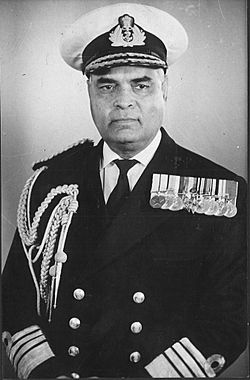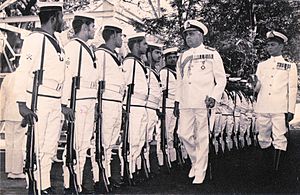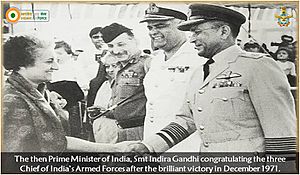Sardarilal Mathradas Nanda facts for kids
Quick facts for kids
Admiral
S M Nanda
PVSM, AVSM
|
|
|---|---|

Admiral Nanda as Chief of Naval Staff
|
|
| Nickname(s) | Charles |
| Born | 10 October 1915 Manora, Karachi, British India |
| Died | 11 May 2009 (aged 93) New Delhi, India |
| Allegiance | |
| Service/ |
|
| Years of service | 1941–1973 |
| Rank | |
| Commands held |
|
| Battles/wars |
|
| Awards | Padma Vibhushan Param Vishisht Seva Medal Ati Vishisht Seva Medal |
| Other work | Chairman and Managing Director Shipping Corporation of India Member of the Board of Directors, Crown Corporation |
Admiral Sardarilal Mathradas 'Charles' Nanda (born October 10, 1915 – died May 11, 2009) was a very important Indian Navy admiral. He served as the 7th Chief of the Naval Staff from 1970 to 1973. He led the Indian Navy during the Indo-Pakistani War of 1971. Under his command, the Navy successfully blocked both West and East Pakistan, which helped India win the war. For his crucial role, the Government of India gave him the Padma Vibhushan, India's second-highest civilian award. He is remembered as one of the greatest commanders in Indian Navy history.
Born in Manora, Karachi, in what was then British India, Nanda joined the Royal Indian Naval Volunteer Reserve in 1941. During World War II, he served on ships and as an instructor. After the war, he continued his service in Japan and later as a communications officer.
After India became independent, he became an executive officer on the ship Cauvery. In 1948, he was appointed first lieutenant of the main ship, HMIS Delhi (C74). He later commanded the destroyer INS Ranjit (1949), which represented India at the coronation review in England. Nanda also commanded other ships like INS Jamuna (U21).
In 1954, he became the Chief of Personnel at Naval Headquarters. He was then chosen to be the first commanding officer of the new main ship, INS Mysore (C60). He brought this ship into service in 1957. In 1958, he became the Director General for the Naval Dockyard Expansion Scheme, where he greatly expanded the dockyard.
Nanda was promoted to a high rank in 1962 and became the Deputy Chief of the Naval Staff. He helped develop Goa as an important naval base. In 1964, he became the managing director of Mazagon Dock Limited, where he prepared for building India's first major naval ships. In 1966, he took command of the Indian Fleet. By 1968, he became the first Flag Officer Commanding-in-Chief Western Naval Command. On March 1, 1970, he became the 7th Chief of the Naval Staff.
Under his leadership, the Navy attacked Karachi with missile boats and bombed ports in East Pakistan. They successfully blocked the enemy's ports on two fronts. For his excellent service, he received the Padma Vibhushan, the Param Vishisht Seva Medal, and the Ati Vishisht Seva Medal.
Contents
Nanda was born on October 10, 1915. His parents were from villages near Gujranwala in British India. He grew up on Manora Island near the Port of Karachi. He was the oldest of seven children. He went to primary school on the island and then to N J High School in Karachi. After school, he worked for the Port and Pilotage department.
When World War II began, he decided to join the Royal Indian Naval Volunteer Reserve. He passed his tests in September 1941 and became an acting sub-lieutenant on October 11, 1941.
Nanda started his naval journey with a training course. He then commanded a river steamer in the Sundarbans. In June 1942, he was chosen for a special communications course at HMIS Talwar, the Signals School in Bombay. After this, he served as the signals officer on the ship HMIS Travancore. In October 1942, he was promoted to acting lieutenant and became an instructor at the Signals School. He chose to stay in the Navy after the war ended.
He was at the Signals School when the Royal Indian Navy mutiny happened in February 1946. This was a protest by sailors that started at his school and spread. The protest ended after the sailors met with Sardar Vallabhbhai Patel.
In June 1946, he was sent to the ship HMIS Narbada (U40), which sailed to Japan. The ship was part of the British occupation forces there. In October 1946, he was given a permanent position in the Royal Indian Navy as a Lieutenant. In January 1947, he became the communications officer of the ship HMIS Cauvery (U10).
After India's Independence
After India became independent in 1947, the ship Cauvery was assigned to India. Nanda became the executive officer of the ship. In 1948, he was promoted to acting lieutenant commander and became the first lieutenant of HMIS Delhi (C74), which was the main ship of the Navy. To prepare for this, he trained with the Mediterranean Fleet.
HMIS Delhi was officially brought into service on July 5, 1948. The ship then sailed to India and was welcomed by Prime Minister Jawaharlal Nehru in Bombay. It then went on a tour around India's coasts and later on a goodwill mission to the Indian Ocean and East Africa.
In June 1949, Nanda was promoted to acting Commander. He was appointed director of personnel services at Naval Headquarters. In October 1951, he took command of the destroyer INS Ranjit (1949). He took the ship on a goodwill tour to places like Singapore and Indonesia.
In 1952, the Ranjit was chosen to escort the royal yacht of Princess Elizabeth (who later became Queen). In 1953, the Ranjit represented India at a huge fleet review in Portsmouth for the Coronation of Elizabeth II. The Indian ships also did exercises with other navies.
Nanda took command of INS Jamuna (U21) in August 1953. In February 1954, he was promoted to acting captain and became the Chief of Personnel at Naval Headquarters in September 1954. He was promoted to full captain in December 1954. In September 1956, he became a commodore.
In December 1956, he was chosen to be the first commanding officer of INS Mysore (C60). This ship was being refitted in England. INS Mysore was officially brought into service on August 29, 1957. Nanda took the ship to the Mediterranean and visited Yugoslavia. After returning to India, the Mysore became the new main ship of the Indian Fleet. The Prime Minister Jawaharlal Nehru also visited the ship. In 1958, Nanda took the ship on a goodwill visit to China and Japan.
On October 1, 1958, Nanda became the Director General of the Naval Dockyard Expansion Scheme. He greatly expanded the dockyard to make it big enough for India's new aircraft carrier. For his excellent work, Nanda received the Ati Vishisht Seva Medal in 1961. After attending a course in the UK, he became the Chief of Materiel in February 1962.
Becoming a Flag Officer
In May 1962, Nanda was promoted to acting rear admiral and became the Deputy Chief of Naval Staff. In this role, he helped get permission to develop the port at Goa as a naval base. He also supported getting equipment from the Soviet Union for the Indian Navy. In December 1964, Nanda became the managing director of Mazagon Dock Limited.
He prepared for building the first major Indian naval ships, the Nilgiri-class frigates. For his excellent service at Mazagon Dock, he received the Param Vishisht Seva Medal in January 1966.
On June 1, 1966, Nanda took command of the Indian Fleet as the Flag Officer Commanding Indian Fleet. His fleet visited the Persian Gulf in April 1967.
Nanda became Flag Officer Bombay on February 1, 1968. In March 1968, he was promoted to vice admiral and became the first Flag Officer Commanding-in-Chief of the Western Naval Command. He organized Navy Week in December 1969, which helped raise the Navy's profile in Bombay.
In November 1969, Nanda was chosen to be the next Chief of the Naval Staff. On March 1, 1970, he became the 7th Chief of the Naval Staff of the Indian Navy. He wanted to change the Navy's mindset from just defending to being able to attack. He got the chance to show this during the war with Pakistan.
The 1971 War
The Indo-Pakistani War of 1971 started because of a conflict in East Pakistan (now Bangladesh). People in East Pakistan wanted more control, but the Pakistani government responded with force. Many East Pakistanis died, and millions fled to India. In April, India decided to help create the new nation of Bangladesh.
Nanda played a key role in planning India's naval strategy during the war. He tricked the enemy by pretending to send his Eastern fleet south, but then secretly moved it north into the Bay of Bengal. This allowed him to block East Pakistan by sea.
Against West Pakistan, Nanda planned to strike hard at Karachi, their main port. He was the mastermind behind Operation Trident and Operation Python. These plans involved using small missile boats, which were usually for coastal defense. They were towed close to Karachi at night to attack naval targets and oil storage tanks.
Operation Trident was a big success on December 4, 1971. It sank a Pakistani destroyer and a minesweeper, and badly damaged another destroyer. It also destroyed many oil tanks. Operation Python was also successful on December 8, 1971.
On the Eastern front, Nanda decided to use the aircraft carrier INS Vikrant in shallow waters near Dhaka. This was to avoid submarine attacks. Even though there were concerns about the carrier's engines, Nanda took personal responsibility for the risk. His bold move paid off, and the Vikrant successfully blocked East Pakistan without any damage.
The war lasted less than two weeks. Over 90,000 Pakistani soldiers were captured, and Bangladesh became a new nation. The success of the naval blockades on both fronts was a major reason for India's victory. For his service, Nanda was awarded the Padma Vibhushan in January 1972.
After Retirement
Nanda retired from the Indian Navy on August 30, 1973. In May 1974, he became the chairman and managing director of the Shipping Corporation of India (SCI), which was India's largest shipping company.
Personal Life
At 21, Nanda married Sumitra. Their marriage was happy and lasted their whole lives. They faced many challenges together, including being uprooted from their home during the partition of India. They had several children, including a son, Suresh Nanda, and a daughter, Beena Mehra.
Sadly, Nanda's daughter Beena died in a helicopter crash. She, her husband, and their daughter were all killed in the crash in 2002. His other two daughters, Ameeta and Devika, survived.
Later Years and Death
In his later years, Nanda wrote his autobiography called The Man Who Bombed Karachi: A Memoir. The book shares his experiences and how India used clever strategies to win against Pakistan. It also covers his 32 years in the Navy.
Admiral Nanda passed away in New Delhi on May 11, 2009, at the age of 93. He was survived by his wife Sumitra (who died in 2011), his son Suresh Nanda, and his grandchildren. His funeral was held with full military honours.
Awards
| Padma Vibhushan | Param Vishisht Seva Medal | Ati Vishisht Seva Medal | General Service Medal 1947 | Samar Seva Star |
| Poorvi Star | Paschimi Star | Raksha Medal | Sangram Medal | Indian Independence Medal |
| 25th Independence Anniversary Medal | 30 Years Long Service Medal | 20 Years Long Service Medal | 9 Years Long Service Medal | |
| 1939–45 Star | Burma Star | War Medal 1939–1945 | India Service Medal | |
| Naval General Service Medal (1915) | Queen Elizabeth II Coronation Medal | |||
Dates of Rank
| Insignia | Rank | Component | Date of rank |
|---|---|---|---|
 |
Sub-lieutenant | Royal Indian Navy | 11 October 1941 (acting) |
 |
Lieutenant | Royal Indian Navy | 11 October 1942 (acting) 19 October 1946 (substantive) |
 |
Lieutenant commander | Royal Indian Navy | 1948 (acting) 30 June 1949 (substantive) |
 |
Commander | Royal Indian Navy | 30 June 1949 (acting) |
| Commander | Indian Navy | 26 January 1950 (recommissioning and change in insignia) 31 December 1950 (substantive) |
|
| Captain | Indian Navy | 15 February 1954 (acting) 31 December 1954 |
|
| Commodore | Indian Navy | September 1956 (2nd class) February 1962 (substantive) |
|
| Rear admiral | Indian Navy | 14 May 1962 (acting) 16 June 1964 (substantive) |
|
| Vice admiral | Indian Navy | 1 March 1968 | |
| Admiral | Indian Navy | 1 March 1970 |
See also
- Field Marshal Sam Manekshaw
- Air Chief Marshal Pratap Chandra Lal



